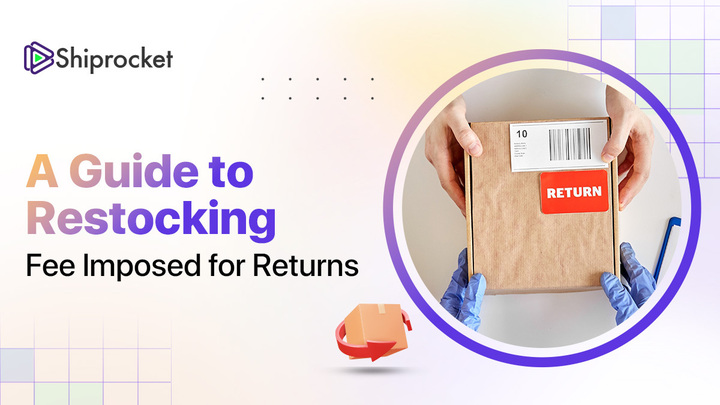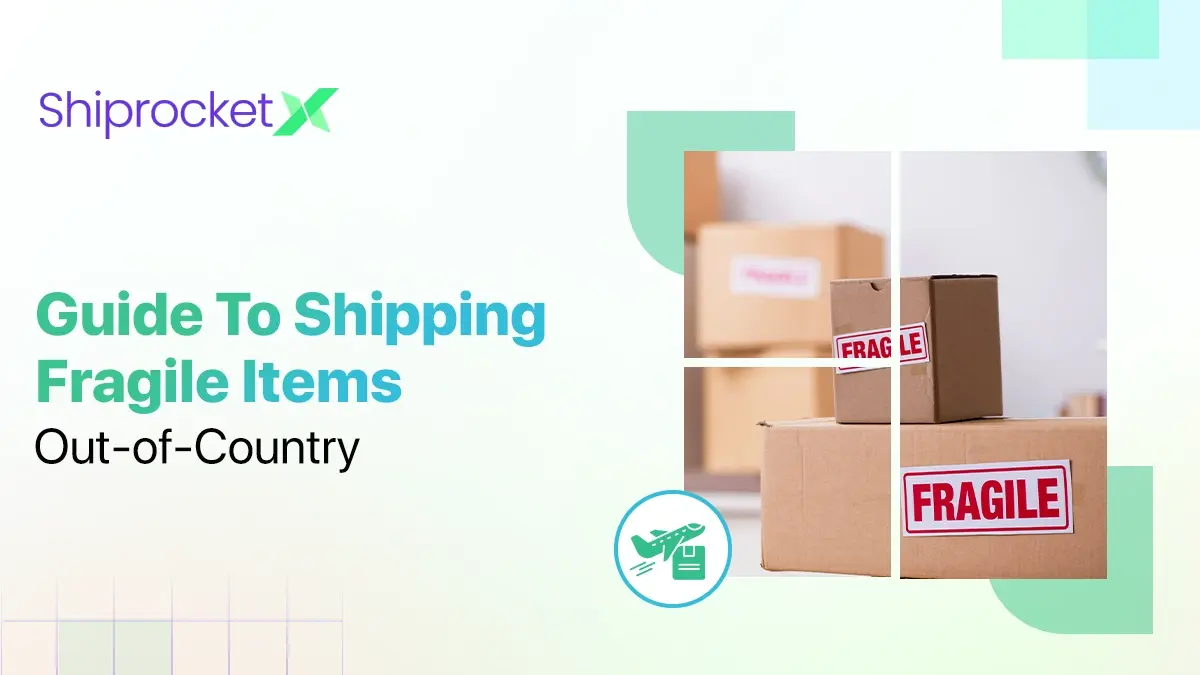Restocking Fees: Strategies for Ecommerce Sellers
The return policy of eCommerce stores has two sides to it. On one hand, it encourages the customer to make purchases even when they’re unsure of keeping it. But the flip side brings challenges and added costs for online retailers. Processing customer returns comes at a considerable cost and can account for a huge loss in revenue for the sellers. eCommerce retailers need to take care of the entire procedure from shipping returned items to reselling them. Therefore, they are now moving from offering customers free returns to charging a restocking fee to cover the expenses.
Many companies charge around 15%-20% restocking fee, which can further increase. But should you charge restocking fees as an eCommerce seller? This article will help you understand how the restocking fee works, the reasons for charging it, and how to charge it.

Restocking Fee: An Explanation
Some businesses charge a restocking fee when a buyer returns an item purchased from their online store. Sellers charge this fee to cover the costs associated with processing the return, inspecting the item, repackaging it, and restocking it for sale. The amount of the fee is usually a percentage of the item’s original purchase price. However, the fee charged may vary depending on the retailer’s policies, the type of product, and the condition in which it comes back.
The purpose of charging a restocking fee is not just limited to recovering costs incurred from handling returns but also to discourage frivolous returns in the future. You’ll commonly find this fee prevalent in industries where returned products are difficult to resell as new or require a lot of extra effort and cost to prepare for resale, like electronics, furniture, or special-order items.
Why Do Companies Charge Restocking Fee?
Companies need to recover many types of additional costs that they bear during and after customers return a product. There are various other reasons also for companies to levy a restocking fee on these returns:
Processing Returns: It’s a daunting task for businesses to handle returns, as it involves many steps including inspection, repackaging, and updating inventory. This process requires labour and materials, which majorly contribute to operational costs that the seller must recover to avoid losses.
Discouraging Unnecessary Returns: A restocking fee acts as a barrier and can deter customers from making impulsive purchases or using the product with the intention of returning. It helps the business to reduce the number of non-defective returns and ensures that customers make more meaningful purchases.
Recouping Costs: Many times customers return products in a non-saleable condition. This may necessitate repair, repackaging, or a discount to be offered for resale. The restocking fee aids the company in recovering a share of these costs.
Inventory Management: Returned items occupy inventory space in the warehouse and you may not be able to resell this stock immediately, especially if these items are seasonal or no longer in high demand. The restocking fee helps you offset the cost of holding and managing this inventory.
Loss of Sale: One of the concerning drawbacks of customer-returned items is that the retailer loses the opportunity to sell that item at full price during its prime selling period. Charging a restocking fee helps you mitigate this loss.
Key Considerations for Online Retailers Before Implementing Restocking Fees
Incorporating the restocking fee can be a challenging task as you may face several risks associated with it. Charging a high fee on returns may lead to losing customers. At the same time, a lower amount may adversely impact your revenue and profit margins.
So, you must take the following factors into account before charging a restocking fee:
Legal Compliance
The restocking fee is taxable under the business and occupation (B&O) tax and falls in the ‘Service and Other Activities’ category. Therefore, there are legalities involved in levying a restocking fee.
So, one of the most important factors to consider while deciding to apply a restocking fee is the terms and conditions under the local laws and regulations laid out by the government. This is to protect your business from any legal issues.
Every country and state has a different consumer protection law. These laws play a role in determining the purchase-price percentage limit that sellers can charge as a restocking fee on returns from customers. Hence, you must seek legal advice before incorporating this fee.
Customer Acquisition Rate
Putting a fee on returns can influence the rate of acquiring new customers for a business. Charging a high restocking may bring your brand in the bad books of the customer and negatively impact their buying decision, in turn reducing the conversion rate. A survey reveals that 84% of online shoppers tend to stop buying from a retailer on having a disappointing returns experience.
The reason for customers backtracking on a purchase due to an unfavourable return policy is that online shopping is intangible and they’re unable to touch, feel, or inspect the product in person. Hence, they become apprehensive about spending a hefty amount on a non-returnable online purchase. Therefore, you must consider setting an optimal restocking fee percentage that helps you recover your loss while also keeping your customers happy.
Determine Return Processing Expenses
You must consider the expenses you would incur during processing your returns, like charges for return pick-up or shipping, inspection, repair, cleaning, repackaging, reshipping of exchange items, and more. Taking these costs into account gives you a clear picture of the real expense involved and helps you decide on a fair restocking fee.
You may not recoup the entire cost, but a part of it may be recovered with a reasonable restocking fee.
Transparency in Communication
Win the trust of potential customers by clearly communicating your restocking fee policy on your website, particularly on the product page, checkout page, and within your return policy. Make sure that customers are aware of the potential charge before they make a purchase.
Transparent communication helps you build strong relationships that harbour loyalty and bring you repeat sales. In contrast, customers may turn their back on your brand if they experience hidden or sudden extra expenses. It gives them a feeling of deceit and they lose trust in your business.
Feedback From Customers
Customer feedback is one of the best ways to understand your customers’ pain points. You can use the feedback to provide them with a better customer experience. Use surveys and other ways to gather this data from your customers and find out whether the restocking fee needs amendment or if they need a longer return window for returning the products.
Considering customer feedback and working on it also helps you strengthen client relationships by building trust. It helps you charge a suitable and reasonable restocking fee for sustaining your business in the long term.
Brand Image
The restocking fee you charge on returns may impact the perception of your brand in a customer’s mind. If buyers are happy or satisfied with your restocking fee, they’re more likely to stay loyal to your brand. Happy customers also tend to spread positive word-of-mouth, nudging their peers to buy from your website. They may even leave some positive reviews about your products or brand, which can increase your future sales.
However, exorbitant restocking charges can attract negative feedback and reviews from your customers. So, you must keep the reputation of your business in mind before making the final decision.
How To Charge Restocking Fees? Strategies and Best Practices
It’s easy to attract and acquire new customers and enhance your sales with exciting offers like flash Sales, discounts, cashback, or free shipping. However, a restocking fee may be a bummer for them and may discourage them from buying products from your websites. Therefore, it’s important to know how to charge an ideal restocking fee to avoid a negative impact on your customers’ purchasing decisions.
Below are some excellent ways to charge restocking fees without highlighting them as an extra cost:
1. Set a Reasonable Rate
The restocking fees generally range from 10% to 25% of the product price. Charge a refundable amount that covers your costs but remains fair to your customers.
The main factors to determine the refundable amount include the reasons for the return and the product’s condition. If a wrong or defective product reaches the customer, you must unhesitatingly refund the entire amount or offer a replacement. However, if there is any other reason, like the customer changing their mind or sending back a used product, then you must request the customer to accept a partial refund after subtracting the restocking fee.
2. Levy a Reshipping Fee
In the case of product exchanges, the online retailer is supposed to reship the item to the customer. You can charge a return shipping fee from the customer if the return is not because of receiving a wrong, damaged or broken product.
You can cut a major expense by claiming the return fee, thus saving a considerable amount of money. Scale this fee based on the return window by implementing a tiered system, where the restocking fee increases with the duration the customer holds the product before returning it. This method encourages quicker returns from customers and reduces the chances of product devaluation.
3. Waive Fees for Exchanges or Store Credit
Extra fees can discourage customers from making purchases, especially when they’re new to your online store. This will adversely affect the sellers and their profit margins. Consider offering exchanges for items of equal or lesser value without charging anything extra to create a mutually beneficial scenario for you and your customers.
Encourage your buyers to exchange products or accept store credit in place of a refund by striking off restocking fees for these options. For example, if a customer registers a return request for a product priced at Rs.5000 and faces a Rs.300 restocking fee, resulting in a Rs.4,700 refund, you may propose an exchange for another item valued at Rs.4,700 instead. This approach incentivises customers to explore other items in your online store, which may lead to more sales.
4. Document Product Condition
Customers may sometimes misuse your return policy and send back the product in deteriorated condition or after using the product several times. It’s best to request your customers to send the purchased products back in their original condition and packaging for successful returns. Make this the eligibility criteria for your returns. Document the state of products upon return to justify any restocking fees when necessary.
Conclusion
Charging a restocking fee for returns is as important as providing your customers with the best experience. The primary goal of your business is to make profits and save it from any potential and unnecessary losses. Businesses face heavy costs when a customer returns their product. From processing the return and repairing the item to reshipping and preparing it for resale, all the burden is on the seller’s shoulders. A nominal restocking fee on returns can help you navigate through these losses and additional costs, while also keeping your customers satisfied. Consider thoughtful strategies like communicating your return policies, clearly outlining restocking fee details on your website, and waiving fees for returned items that are defective or damaged. Moreover, offer alternatives like store credits or exchanges that can help manage returns more effectively while maintaining customer satisfaction and loyalty.





